ISSN ONLINE(2319-8753)PRINT(2347-6710)
ISSN ONLINE(2319-8753)PRINT(2347-6710)
B.N.Sarada1, P.L. Srinivasamurthy2, Swetha3
|
| Related article at Pubmed, Scholar Google |
Visit for more related articles at International Journal of Innovative Research in Science, Engineering and Technology
The research for new materials that could be used for components with complex geometry in automotive and aircraft industries led to exploitation of Al-Si-Mg alloys. Aluminium alloys are known for easy machinability and very good casting characteristics. In this present investigation Al- 7.0Si- 0.6Mg alloy castings confirming to A357 were produced by Sand casting method and Gravity die casting method. For substantial improvement in mechanical properties Modification was carried out by adding 0.01% Sodium and 0.01% Strontium to the molten metal just before pouring into moulds. Metallographic examination was carried out to reveal the constituents and structure by means of “metallurgical Microscope”. The microstructures of as-cast alloy showed dendritic structure with large primary aluminum dendrites and the eutectic phase. Modification treatment changed Silicon morphology from needle like structure to fibrous structure, which improved mechanical properties and wear resistance of A357 alloy. The results are presented in the paper.
Keywords |
| A357 alloy, Sand casting, Gravity die casting, Modification, Metallurgical microscope, Silicon morphology. |
INTRODUCTION |
| Aluminum is a soft, durable, lightweight, malleable, silverish white metal. Aluminium base alloys find extensive application in Automobile industry, Air craft industry and other general engineering industries due to their good corrosive resistivity and good strength to weight ratio. |
| Al-Si-Mg alloy is categorized as Cast Aluminum Alloy. These alloys can be sand cast, chill cast; can be grain refined as well as modified. The major alloying elements in A357 alloy are Silicon and Magnesium. Si is the major alloying element, which imparts good Castability, high wear resistance and Hardness. Small addition of Mg improves solution treatment and age hardening characteristics of these alloys. Good melting practice and the use of correct techniques are primary requisites for achieving an end product that retains desired metallurgical properties. For substantial improvement in properties, modification is carried out by the addition of small quantities of sodium and strontium to the molten metal just before pouring in to moulds. Modification is a process of changing the shape of the second phase elements, by enhancing its growth and enhancing the property of the alloy to bring about the change in its shape. The percentage of these modifying elements is very small but the effect is remarkable. Modification is carried out extensively in aluminum silicon alloys. Modification is one of the important melt treatments because it improves the mechanical properties by changing the microstructure of the material. Unmodified alloys contain silicon in the form of brittle flakes which leads to poor ductility of the material. The commonly used modifiers are of Strontium and Sodium in Al-Si alloy industry because they are easy to handle, have good modification rate, a long incubation time and a low fading effect. The modifying effect of sodium in the development of an adequate structure is positive it vanishes with time known by a phenomenon “fading”. Alternatively extensive effort is being carried out in order to replace sodium by strontium for the modification of Al-Si eutectic alloys. One important feature of strontium is to consistency in producing castings of good quality. Some important modifiers are Antimony, Sodium, Strontium and calcium. |
| Micro structural features are product of metal chemistry and solidification conditions. The microstructure features, which mostly affect mechanical properties are Size, form and shape of inter-metallic phases, grains, eutectic and DAS. |
METHODOLOGY |
| A. Production of Castings |
| In this present investigation, wooden Split pattern (Plate 2.1) was used for producing sand castings. |
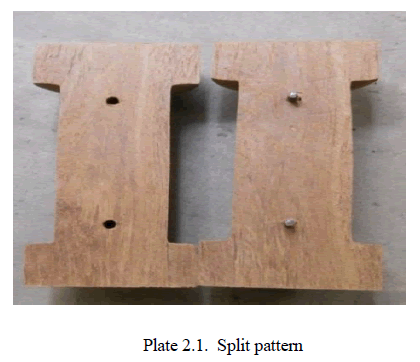 |
| Green Silica sand with AFS grain Fineness number 25 was used as mould material. The other ingredients were 11.2% Bentonite (Clay binder), 3.25%moisture, 2.5% Coal dust (to improve surface finish). The ingredients were mixed thoroughly for about 3-5 minutes and mould boxes were prepared (plate2.2) to produce castings. |
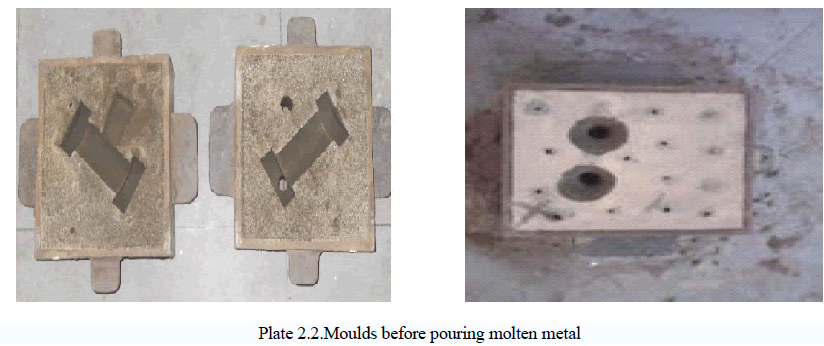 |
| Cast iron metallic mould (diameter 60mm and height 175mm) was used in gravity die casting method. Two die halves (plate 2.3) were used to produce the casting. The die halves were cleaned and coated with a refractory mould coat. Then the dies were preheated, closed and clamped. |
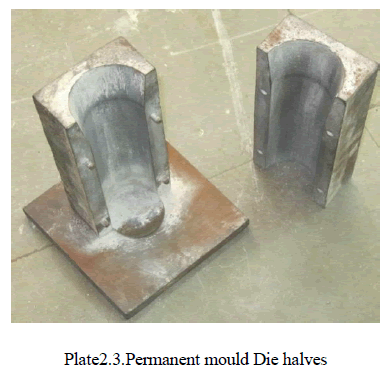 |
| The most important step in production of castings is Melting & Pouring. The melting operation was carried out in an electric arc furnace (Plate 2.4a&2.4b). The charge (A357 ingots) were taken in crucible of capacity 5kg and heated to 850oc for 4hours. Then the molten metal was degassed using hexa-chloroethane (c2cl6) tablets (Plate2.5a&2.5b). The tablet was powdered and plunged into the metal and held at the bottom to enable chlorine gas to purge through the melt and remove the dissolved gases. Then the slag was removed. |
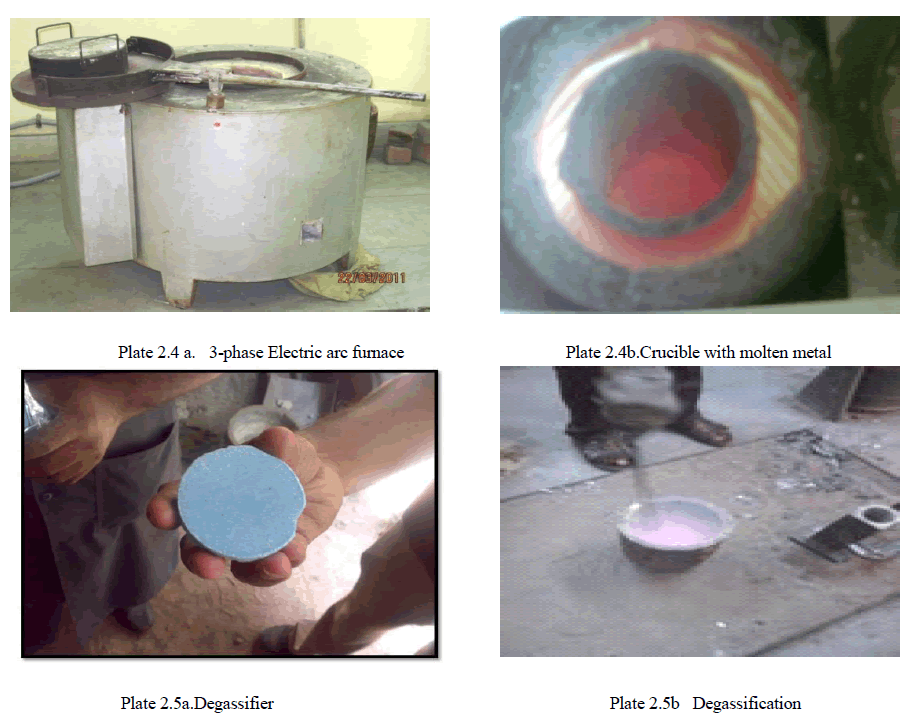 |
| .After 5 minutes the molten metal was poured into the cavity via spruce/pouring cup without any modification treatment and allowed to solidify under gravity as shown in the Plate2.6. &2.7. The specimen were left to cool for 1 hr. Then the moulds were broke opened and the specimen were taken out. |
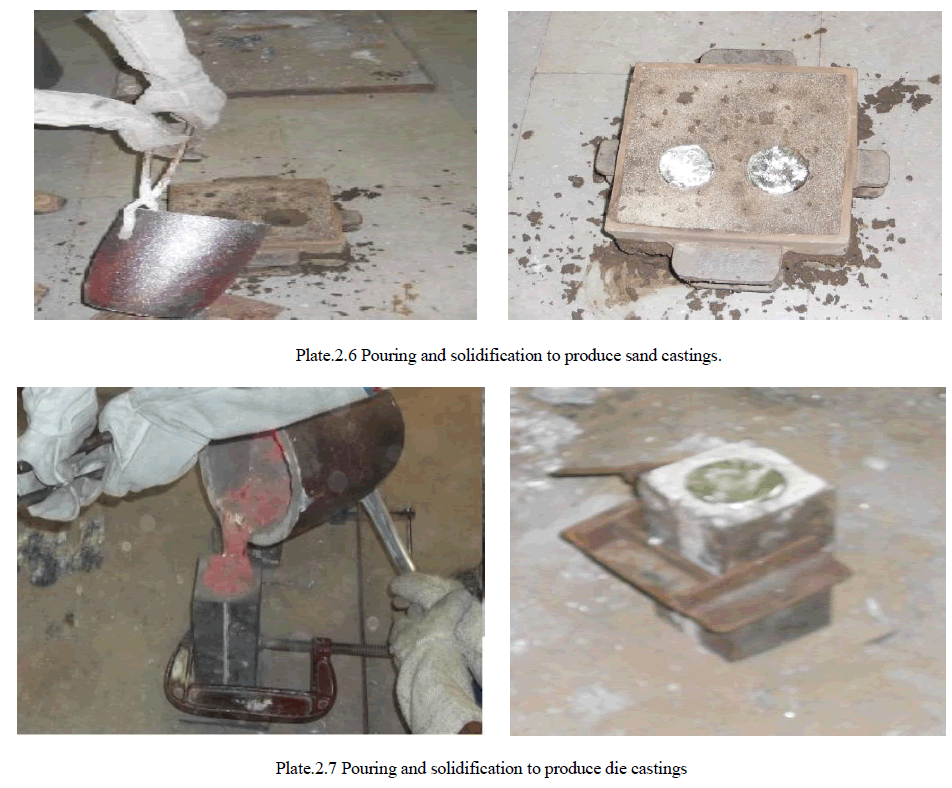 |
| B. Sodium Modification |
| 4kgs of A357 alloy was taken in a crucible and heated in a coke furnace to 850oC for 3hrs. 2gm of salt of sodium [88% (Nacl+Kcl) +12%NaF]) was added. 100gm of 1T cleaner was added to remove impurities. Then 50gms of degasser was added to remove the gases after 5 min the molten metal was poured into moulds at720oC. |
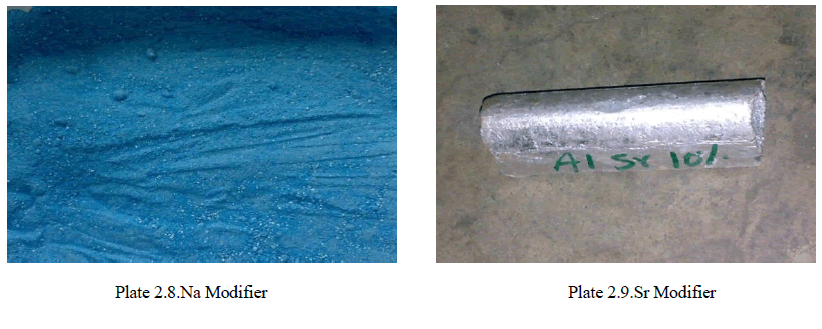 |
| C. Strontium Modification |
| 4kgs of A357 alloy was taken in a crucible and heated in a coke furnace to 850oC for 3hrs. 25gm of Al -10%Sr alloy was added. 100gm of 1T cleaner was added to remove impurities. Then 50gms of degasser was added to remove the dissolved gases After 5 min the molten metal was poured into moulds at720oC. |
| D. Microstructural study: |
| The metallographic specimen was prepared in accordance with ASTM standards ASTM E 340 & ASTM E407. The |
| specimen for microstructure analysis was machined in the form of cylindrical pieces of 20 mm diameter, 20 mm thickness to as shown in plate2.10. These samples were ground and polished using a polishing machine (Plate2.11). The samples were then washed, dried and photographed using metallurgical microscope (Plate2.12) in both unetched and etched conditions (etchant0.5% HF) . |
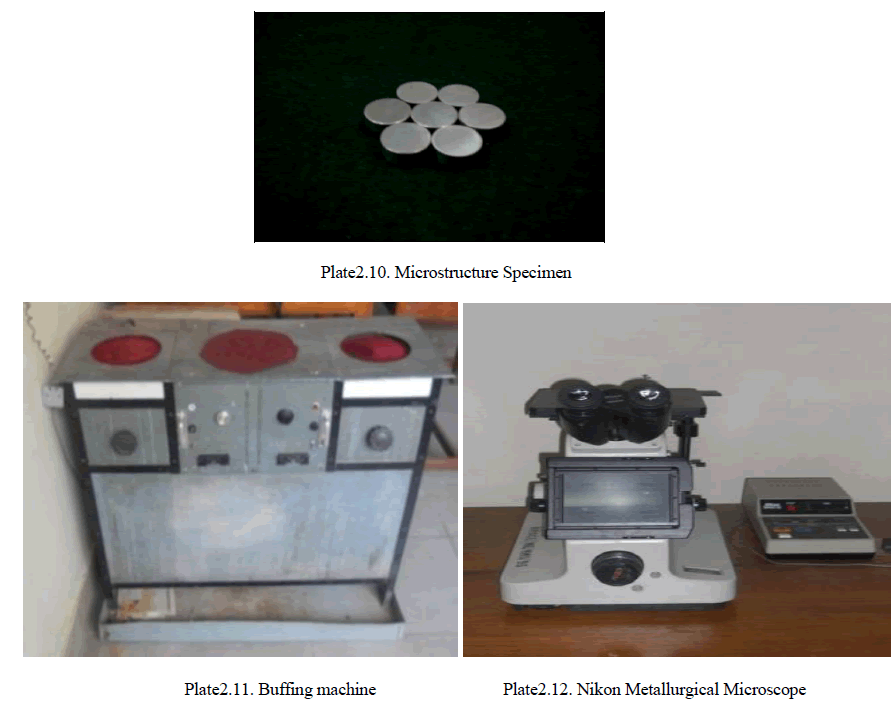 |
RESULTS AND DISCUSSION |
| Photographs of specimen tested for different testing conditions are taken using metallurgical microscope and the results are shown below. |
| A. Effect Of Modification on Si Morphology Sand Cast Specimen |
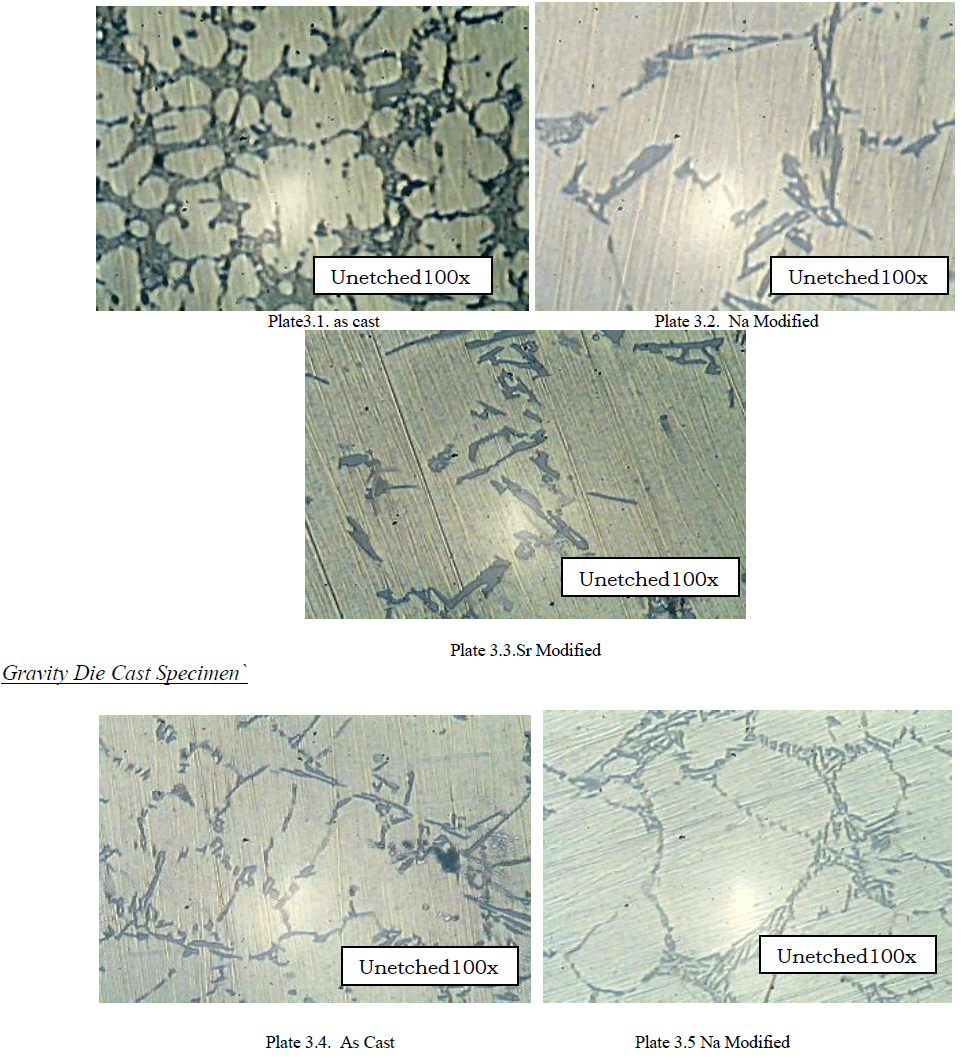 |
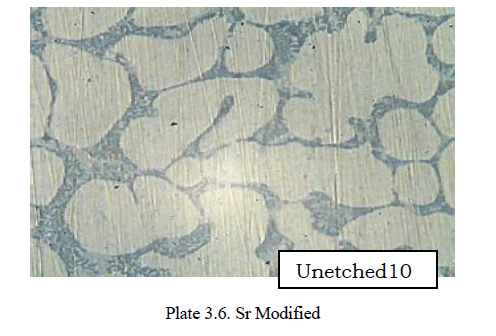 |
Discussion on Results |
| Sr or Na addition in A357 alloys (Plate3.2, 3.3, 3.5, 3.6) depressed the growth of the α -Al dendrite and Al-Si eutectic and influenced their growth mechanism. This effect was more significant with higher cooling rate as in case of permanent mould casting. Due to addition of these modifiers Primary α -Al dendrites have become more equiaxed and Al-Si eutectic much finer. The microstructure shows the primary α Al phase and the eutectic distributed among the globular grains of primary phase. Sr or Na additions to hypoeutectic aluminum-silicon alloys resulted in a finer lamellar or fibrous eutectic network. The Modification has given better results with Sr addition than Na. Silicon needles are coarser and more acicular in Sodium modified specimen than Sr modified specimen. |
| B. Effect Of Casting Method on Microstructure |
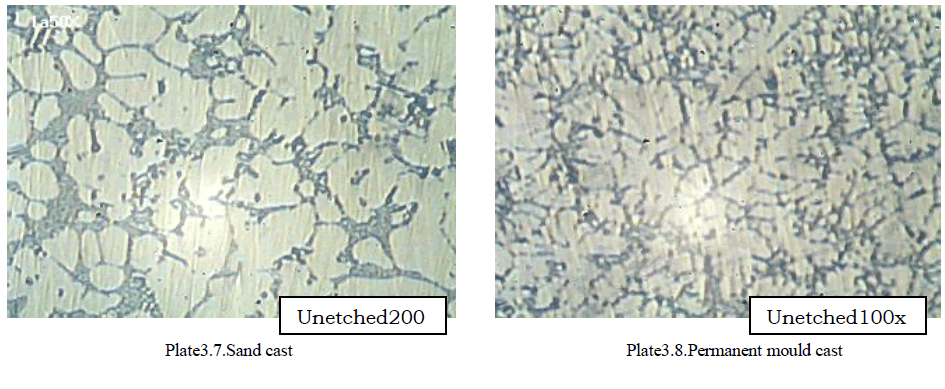 |
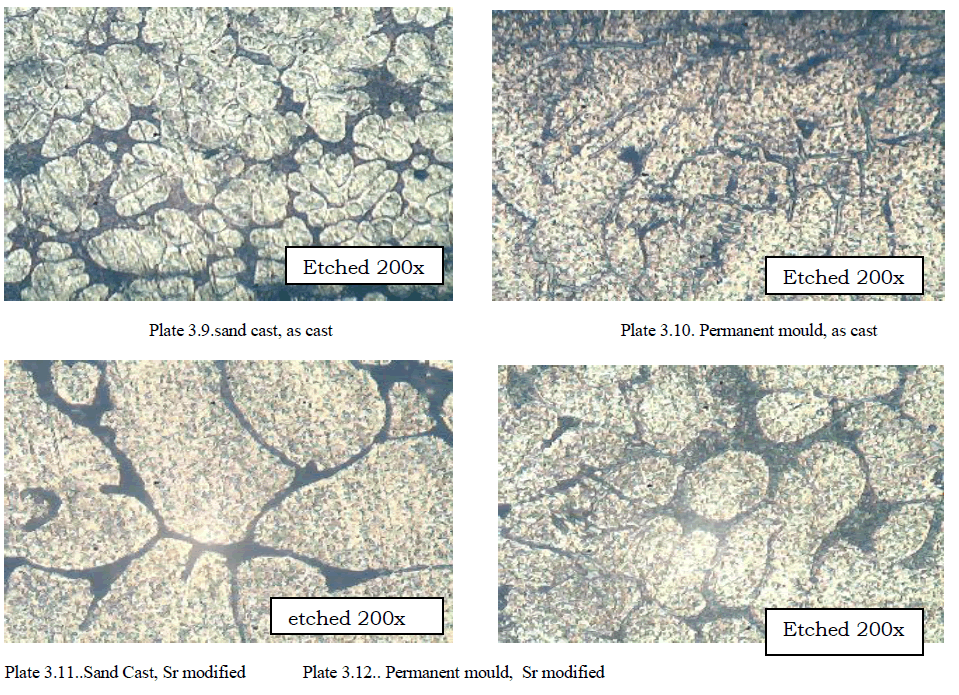 |
Discussion on Results |
| The microstructures of the components (Plate 3.7 to 3.10) consist of dendrites of primary α Al phase and eutectic. The eutectic is more or less uniformly distributed among the grains of the primary phase. It was observed the size of dendrites size and interdendritic arm spacing was less in case of gravity die cast specimen than sand cast specimen. This can be attributed to faster cooling rate in case of die casting than the sand casting. The same trend was observed with Modification treatment and solutionization treatment. |
| C..Effect Of Modification And Casting Method On Dendritic Cell (Grain)Size. |
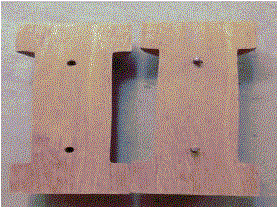 |
Discussion on Results |
| From the above graph it can be observed that Dendritic cell size of permanent cast specimen was much smaller than the sand cast specimen. The decrease in grain size was about 24%.This could be due to faster cooling rates in Permanent mould casting. Modification also slightly decreased the grain size . It was 1.2% in case of Sr modified(Sand cast) specimen and 4.46 % in Permanent mould, Sr modified specimen.This could be due to action of modifiers on growth mechanism of phases. |
SUMMARY & CONCLUSIONS |
| From the results and disscustion the following conclusions are drawn. |
| A357 (Al-Si-Mg) alloy castings are produced as per ASTM procedures. |
| Effects of Modification on microstructural properties of A357 alloy are studied experimentally. |
| Microstructure of as cast specimen has shown dendritic morphology of the conventional cast sample. |
| Sr or Na addition in A357 alloys depressed the growth of α -Al dendrite & Al-Si eutectic and also influenced their growth mechanism. Due to addition of these modifiers Primary α -Al dendrites have become more equiaxed and Al-Si eutectic much finer. |
| Silicon needles are coarser and more acicular in Sodium modified specimen than Sr modified specimen. |
| This above effect is more significant with higher cooling rate as in case of permanent mould casting. The increased solidification rates are useful in providing a finer distribution of lamellae relative to the growth of the eutectic. |
ACKNOWLEDGEMENT |
| I thank the Management of B.M.S.College of Engineering , Dr. K Mallikarjuna Babu Principal, B.M.S.College of Engineering, Bangalore, India for motivating and providing research facilities at B.M.S.C.E. for carrying out research. I take this as an opportunity to thank Late.Dr.K.Radhakrishana, B.M.S.C.E for all the help, Inspiration, support and guidance, he has rendered to carryout research work. I would also like to thank Dr.Guruprasad, Prof and Head of Mechanical Department,B.M.S.C.E and other departmental colleagues and friends who are continueously encouraging and supporting for my reasearch work. |
References |
|